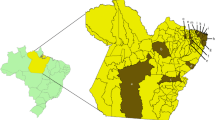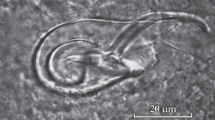Abstract
The natural arthropod and helminth infections of a vast colony of a West African fruit batEidolon helvum were studied over a period of 2 years. The seasonal prevalence of a non-specific ectoparasiteCyclopodia greeffi Karsch, 1884 is presented, while the complete absence of endoparasitic infection in the gut is noted. A single helminth infection withConcinnum epomopis Sandground, 1937 (Digenea) in the pancreas was found. This digenean is redescribed and data on the occurrence is presented. Helminth infection as a means of population control of the fruit bat is ruled out, as infections appeared to be accidental; the factors determining the prevalence and frequency of infections are considered. The significant factors responsible for the general overall poor helminth fauna of fruit bats in comparison to the generally diverse helminth fauna of the local insectivorous bats are discussed. Histopathological changes resulting from infection are recorded.
Similar content being viewed by others
Abbreviations
- C :
-
cirrus
- CS :
-
cirrus sac
- Cvd :
-
collecting vitelline duct
- Crd :
-
collecting vitelline duct
- E :
-
egg
- Ed :
-
ejaculatory duct
- GA :
-
genital atrium
- GSC :
-
giandular secreting cells
- Lc :
-
laurers' canal
- O :
-
ovary
- OS :
-
oral sucker
- Ot :
-
ootype
- Ov :
-
oviduct
- pp :
-
pars prostatica
- Sp :
-
spermatozoa
- SV :
-
seminal vesicle
- T :
-
testes
- Tb :
-
body tegument
- U :
-
uterus
- V :
-
vitelline glands
- Vs :
-
ventral sucker
References
Ayensu ES (1974) Plants and bats interactions in West Africa. Ann Mo Bot Gdn 61:702–727
Baylis HA (1936) The fauna of British India including Ceylon and Burma. Nematode (Ascaroidea and Strongyloidae) Vol. 1 Taylor and Francis London, p 408
Bhaleroa GD (1936) Studies on the helminths of India. Trematoda I. J Helminthol 14:163–180
Denton JP (1942) Eurytrema procynotis sp. Trematode. Dicrocoeliidae) from the racoon,Procyon lotor. Proc Helminthol Soc Wash 9:29–30
Denton JP (1944) Studies on the life history ofEurytrema procynotis Denton, 1942. J Parasitol 30:277–286
Faveaux MA de (1965) Les parasites des chiropteres. Role epidemologique chez animaux et l'homme en Katanga (1) Ann Parasit Hum Comp 40:21–28
Halstead HB (1977) Fruit bats — an example of wildlife management. The Nigerian Field 42:50–57
Happold DCM, Happold M (1978) The fruit bats of Western Nigeria. Part 3. The Nigerian Field 43:121–127
Heyneman D, Macy RW (1962) Helminths reported from bats (Chiroptera) in Egypt with an illustrated key to the common flukes. J Egypt Publ Hlth Ass 25:109–142
Holmes JC (1966) Factors influencing the trematode fauna of bats. Proc 1st Congr Parasit Rome 1:490–492
Meggit FJ (1926) On a collection of Burmese cestodes. Parasitology 19:230–237
Mutere FA (1973) On the food of the Egyptian fruit bat,Rousettus aegyptiacus E Geoffroy Period Biol 75:159–162
Ogunbiyi A, Okon EE (1976) Studies on the digenetic enzyme pattern of the fruit batE. helvum (Kerr). Comp Biochem Physiol 55:359–361
Railliet A, Henry A, Joyeux C (1912) Sur deux Trematodes de Primate Bull Soc Parasitol Exot 5:833–837
Rhode K (1966) Trematodes of Malaya Proc 1st Congr Parasit Rome 1:492–493
rosevear DR (1965) The bats of West Africa Br Mus (Nat Hist), London
Sandground JH (1937) Three new dicrocodiidae from African Chiroptera. In: Papers of helminthology, Skrjabin's Jubilee volume. All Union Lenin Academy of Agricultual Sciences, Moscow p 581–585
Saoud MF, Ramadan NM (1976) Studies on the helminth parasites of bats in Egypt and the factors influencing their occurrence with particular reference to digenetic trematodes. Z Parasitenkd 51:37–47
Stiles CW, Nolan MO (1930) Key catalogue of parasites reported for cheiroptera bats, with their possible health importance. NIH Wash Bull No 155:603–789
Stunkard HW, Gross LJ (1950)Eurytrema brumpti (Railliet, H. and Joyeux, 1912) Trematoda: Dicrocoeliidae, from the pancreas and liver of African apes. J Parasitol 36:574–581
Timon-David J, Timon-David P (1968) Progress recents et perspectives dans la connaissance du cycle vital chez les trematodes digenetique de la famille des Dicrocoellidae. Annls Fac Sci Marsielles 41:121–140
Wilson DE (1973) Bat faunas: A topic comparison. Syst Zool 22:14–29
Yamaguti S (1975) A synoptical review of life histories of digenetic trematodes of vertebrates with special reference to the morphology of their larval forms. Keigaku Publishing, Tokyo
Yamashita J (1963) Ecological relationships between parasites and primates. I. Helminth parasites and primates. Primates 41:1–121
Author information
Authors and Affiliations
Rights and permissions
About this article
Cite this article
Otubanjo, O.A. Concinnum epomopis Sandground, 1937 (Dicrocoeliidae) from the pancreas of the West African fruit batEidolon helvum in Nigeria. Z. Parasitenkd. 71, 485–494 (1985). https://doi.org/10.1007/BF00928351
Accepted:
Issue Date:
DOI: https://doi.org/10.1007/BF00928351




